One juror’s diary
Day 2: our criteria
(Click here to go to the original post in Italian.)
Second day
At five in the morning, in my hotel room, a thought woke me up: I was so excited to have been invited to Bologna, that I had completely forgotten what it really meant, for me, being the juror in such a prestigious exhibition. I tried to go back to sleep: no way. I was thinking about what illustration meant for me, and my blog, and everything that had brought me there. Thought after thought, I went back to 7-year-old me, as I was flipping through an illustrated book. That primitive, absolute marvel to have in those pages a world all for me, a world where I could live in, and go back to visit if I had missed something. The illustrated books had helped me. Childhood is not that happy kingdom that many people think. That was it: the real reason for me to be there was to defend precious images.
At 8 I went downstairs for breakfast. Kitty was already there, and I immediately started to talk to her about the importance of giving the children a true and profound culture (I was saying that to Kitty Crowther!, one of the most courageous illustrators in the world, the winner of the “Noble prize” for illustration…) and how big a responsibility we had as judges. I was sure that she was thinking, while staring at me, “this girl is nuts.”
Instead, she waited for me to finish, and then she began telling me her dream: she dreamed that it was us who were going to be judged as pastry chefs (!).
When Isabel and Errol joined us, we went on with the conversation. Isabel suddenly said, more or less: “We have to tell the kids about the things that are important to us; we should not create a culture that is custom-tailored.” Errol, pragmatically, talked about the importance of teaching the children how crucial it is to be able
to change point of view: this is the essence of creativity. The world of tomorrow will be saved by creative people, who are able to face the problems from different angles.
We were going back and forth between French and English. I was delighted by our harmony: I couldn’t hope for more exquisite colleagues.
We looked at the time: it was late, and the driver was waiting for us.
When we arrived to the Fair, we finished working the tables that were left from the day before. By now, the big hall felt familiar to me. The idea of spending another long work day made me feel that happy tiredness that you feel in your arms after doing physical work outside. But now with the knowledge of being better able to control gestures and emotions.
The definition of the criteria
When we were done with the tables, it was already 11 o’clock. The directors invited us to sit down, and take an hour to define the criteria by which we would judge the work. We were free to create our Exhibition, with no obligations or restrictions.
We looked at each other and we smiled: we practically already had our criteria. One word summed it all up: honesty.
We would favor the illustrations in which it was clear that the artists challenged themselves, trying to say something important for them. Something honest, personal, detached from any trend.
Errol pointed out how difficult it is to compare illustrations that were taken from books with others that were unpublished or done on purpose for the competition. We then decided to act as if we were editors, who receive mountains of different images: we would evaluate whether the images could give life to an illustrated book for children.
Roberta Chinni, the Fair’s director, explained to us that the Fair is for publishers of books for children aged 0 to 16. So, we would choose the best images for children aged 0 to 16, based on the honesty with which they were made and the level of innovation they brought to the international landscape. (If you think that we rejected an illustrator who created five astounding illustrations, but practically identical to what a 19th century illustrator would have done, you’ll understand the importance of the criteria.)
Another criterion was that the technique had to be good, but not overrefined at the expense of the message’s spontaneity.
Lastly, we would favor, above a level of quality that was clear to us all, images in which we felt that the illustrator had taken a risk.
We would define more criteria during the actual selection.
Before lunch, we answered a few questions posed by the students of MiMaster, the illustration school based in Milan.
At lunch, we had the pleasant surprised of being joined by Satoe Tone, who was there to work on a book with the Fundación SM (the SM award gives 30,000 Euros and the possibility to create a book that is presented at the next year’s Fair. Satoe won the prize in 2013). She is delightful.
After lunch, the organizers gave us a bunch of Post-Its of four different colors, one color for each of us.
The first survey over the 200 plus illustrators still in the run was do be done solo, expressing our judgement placing a full sticker if we were 100% sure; half a sticker if we had doubts; and no sticker if we were no longer convinced by the work.
At the end, we would see which images had four full stickers and hence already chosen for the exhibition; which ones we would have a conversation about; and which none of us felt like discussing.
With my great surprise, having the criteria now clear in my mind changed the way I looked at them. It was no longer “I like it,” but: “Was the illustrator honest, or he just wanted to please?” and: “Would have I liked this when I was eight, or thirteen?” and: “Is there something new in this work?”
It was important, and difficult, to try to identify sincerity in languages and styles that were so far away from the European way, since there were 191 countries represented.
About ten illustrators, or maybe fewer, received four full stickers. Those were images that convinced us without hesitation from day one.
We laid them on two long empty tables. How depressing! It was the smallest ever illustration exhibition! We felt better when we took a look at all the piles with three Post-Its: another ten or so. Only twenty illustrators we all quite agreed on. And the others? How could we get to eighty? But it was 7 P.M. and we were exhausted. I was dreaming of a hot shower and dinner. Who knows me knows how my face looks like when I’m hungry. For my joy, we were treated as royalty: as soon as I was about to turn pale, Deanna Belluti would arrive with a tray, asking casually: “who wants a pastry?”
If I have to choose one illustration among the ones that got four Post-Its, as an example of our unanimity, I’d pick this one by Arianna Vairo, which you’ll see at the show. The power and the freshness of her work is impeccable; her courage and honesty, out of discussion.
In my next piece, I will tell you about the third day, which was the most fascinating: that’s when we had to start seriously and passionately discussing the “why yes” and “why no” for each group of illustrations.








